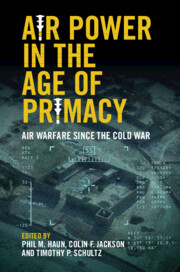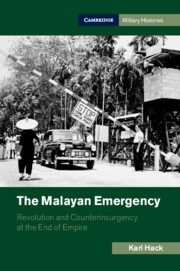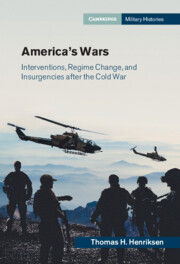Refine search
Actions for selected content:
15366 results in Military history

Dear John
- Love and Loyalty in Wartime America
-
- Published online:
- 04 January 2022
- Print publication:
- 06 January 2022

Air Power in the Age of Primacy
- Air Warfare since the Cold War
-
- Published online:
- 16 December 2021
- Print publication:
- 16 December 2021

The Malayan Emergency
- Revolution and Counterinsurgency at the End of Empire
-
- Published online:
- 16 December 2021
- Print publication:
- 16 December 2021

America's Wars
- Interventions, Regime Change, and Insurgencies after the Cold War
-
- Published online:
- 16 December 2021
- Print publication:
- 20 January 2022
Appendix 1 - Emergency Statistics, 1948 to 1960
-
- Book:
- The Malayan Emergency
- Published online:
- 16 December 2021
- Print publication:
- 16 December 2021, pp 455-458
-
- Chapter
- Export citation
4 - Bureaucratic Counter-Terror and MNLA Main Forces
-
- Book:
- The Malayan Emergency
- Published online:
- 16 December 2021
- Print publication:
- 16 December 2021, pp 139-190
-
- Chapter
- Export citation
Copyright page
-
- Book:
- The Malayan Emergency
- Published online:
- 16 December 2021
- Print publication:
- 16 December 2021, pp iv-iv
-
- Chapter
- Export citation
Abbreviations
-
- Book:
- The Malayan Emergency
- Published online:
- 16 December 2021
- Print publication:
- 16 December 2021, pp xvi-xix
-
- Chapter
- Export citation
Additional material
-
- Book:
- The Malayan Emergency
- Published online:
- 16 December 2021
- Print publication:
- 16 December 2021, pp xx-xxii
-
- Chapter
- Export citation
Tables
-
- Book:
- Air Power in the Age of Primacy
- Published online:
- 16 December 2021
- Print publication:
- 16 December 2021, pp viii-viii
-
- Chapter
- Export citation
9 - Coercing a Chaos State: The Saudi-Led Air War in Yemen
-
-
- Book:
- Air Power in the Age of Primacy
- Published online:
- 16 December 2021
- Print publication:
- 16 December 2021, pp 201-228
-
- Chapter
- Export citation
Preface
-
- Book:
- Air Power in the Age of Primacy
- Published online:
- 16 December 2021
- Print publication:
- 16 December 2021, pp xiii-xiv
-
- Chapter
- Export citation
2 - Remote Warfare: A New Architecture of Air Power
-
-
- Book:
- Air Power in the Age of Primacy
- Published online:
- 16 December 2021
- Print publication:
- 16 December 2021, pp 26-53
-
- Chapter
- Export citation
Contents
-
- Book:
- The Malayan Emergency
- Published online:
- 16 December 2021
- Print publication:
- 16 December 2021, pp v-vii
-
- Chapter
- Export citation
Appendix 2 - The Second Emergency, 1968 to 1989
-
- Book:
- The Malayan Emergency
- Published online:
- 16 December 2021
- Print publication:
- 16 December 2021, pp 459-467
-
- Chapter
- Export citation
Copyright page
-
- Book:
- Air Power in the Age of Primacy
- Published online:
- 16 December 2021
- Print publication:
- 16 December 2021, pp iv-iv
-
- Chapter
- Export citation
4 - Hoping for Victory: Coercive Air Power and NATO’s Strategy in Kosovo
-
-
- Book:
- Air Power in the Age of Primacy
- Published online:
- 16 December 2021
- Print publication:
- 16 December 2021, pp 76-96
-
- Chapter
- Export citation
Contents
-
- Book:
- Air Power in the Age of Primacy
- Published online:
- 16 December 2021
- Print publication:
- 16 December 2021, pp v-vi
-
- Chapter
- Export citation
Note On the Text: Language, Terminology and Measures
-
- Book:
- The Malayan Emergency
- Published online:
- 16 December 2021
- Print publication:
- 16 December 2021, pp xiv-xv
-
- Chapter
- Export citation
Figures
-
- Book:
- The Malayan Emergency
- Published online:
- 16 December 2021
- Print publication:
- 16 December 2021, pp viii-viii
-
- Chapter
- Export citation
